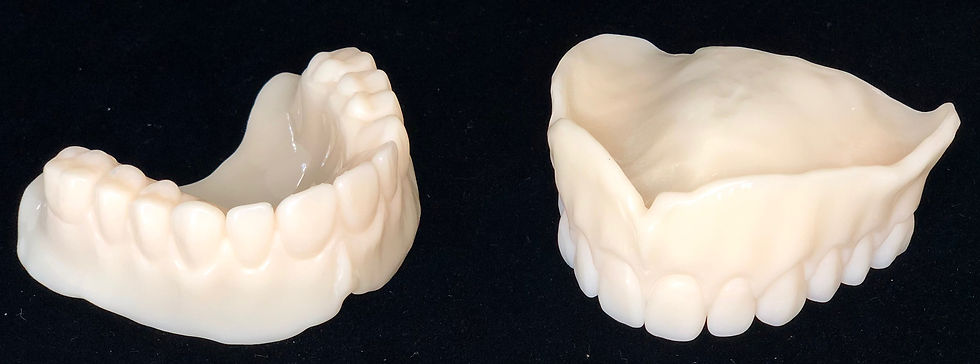Digital vs conventional dentures
- Esther Watai
- Jan 9, 2019
- 3 min read

Is the future of dentures digital? Like in every other manufacturing business we tend to turn to computers and skip the manual labour, eliminating human errors. By introducing the digital workflow to the denture manufacturing process the dental technician saves valuable time compared to manual production methods: fewer manual working steps, less interruptions in production, no complex plaster models and no articulating.
You would think by creating your denture with the computer it would loose the artistic side of the process. However this is not the case. Just like beautiful handcrafted dentures, where the technician carves the shape of the gum and characterises your teeth individually, exactly the same method can be applied designing your denture on the computer screen but the technician would use the mouse instead of the wax knife.
Recently I was fortunate to be part of an experiment, where we made two sets of dentures for the same person at the same time, using the same clinical process (impressions), but one was made manually in the lab , set up the teeth using the traditional method and using the Ivocap processing system. The other set was made in a digital workflow, where the impression and bite registration was simply scanned into the computer, skipping the messy plaster pouring process and maintaining the highest accuracy. Millwater based Procast Dental Laboratory owners latest investment is the 3 Shape Scanner and the Ivoclar PrograMill PM7 milling machine. He was generous to offer his time and skill to create the digital denture for my patient John.
So you must wonder, but how? How can a machine make a denture just as good if not better? Simple as it is, it’s all just a computer software with data and knowledge gathered in the last century from technicians, dentists and all other dental professionals. I have included pictures of a digital workflow for you to understand this:
Part of the scanning procedure with the 3Shape scanner:

A screenshot of the computer screen with the denture design:

We printed out the denture for try in, where we checked the teeth position and the occlusion (bite):

The final product after the milling:

The patient comments were: ”This is fascinating. I couldn’t have actually imagined how you going to do it without touching a wax knife. I have to say the most noticeable difference is the feeling of it. The digital denture feels like a slim, delicate piece in my mouth, while the traditional denture is same as my old one, feels a bit chunky and monstrous compare to the digital. Aesthetically I can’t tell the difference, but probably because I am a bloke. They both look good and natural. The bite feels even and balanced on both dentures. “
Our aim was to compare the fabrication of digital and conventional dentures with regard to their clinical performance, accuracy, retention and fit, speech and aesthetics, fabrication time, patient satisfaction as well as fabrication-related complications.
Studies indicate that digital manufacturing has higher technique accuracy compared to conventional methods. With respect to retention, fit and stability of complete dentures produced by the two compared fabrication techniques, multiple studies showed variable results with slight superiority of the digital dentures over conventional dentures.
The conclusion of this trial, is that no significant difference was found between the conventional and the digital dentures with regard to aesthetics and speech. Higher patient preference and satisfaction was expressed for the digital denture.
In a clinician patient relationship choosing either digital or conventional would make no difference, because at this stage we still have to take impression and other measurements. However for the clinician and lab manufacturing side the denture fabrication on a digital is more accurate, with less work by a human hand, which eliminates human errors and is also more fun for the technician to work with a high-tech system.
This blog was written for the public to understand where the denture manufacturing is heading these days and is not to be used as a scientific reference or study model.



















Comments